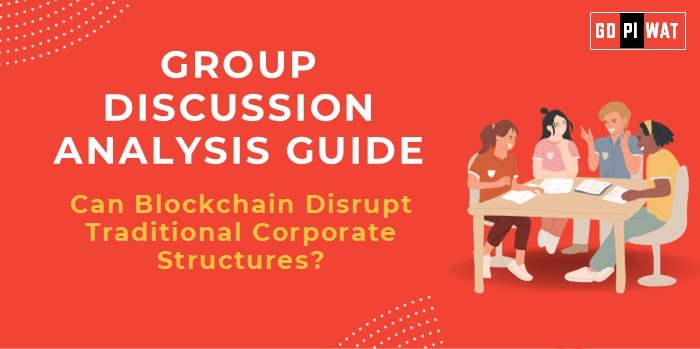📋 Group Discussion Analysis Guide: Can Blockchain Disrupt Traditional Corporate Structures?
🌐 Introduction to Blockchain and Traditional Corporate Structures
- Opening Context: “Blockchain technology, often synonymous with cryptocurrencies, has evolved into a revolutionary framework with the potential to fundamentally alter traditional corporate hierarchies and management systems. By promoting transparency, decentralization, and immutability, it questions the need for central authority in corporate decision-making.”
- Topic Background: Blockchain, a distributed ledger technology, eliminates intermediaries and ensures trust through secure, transparent, and automated processes. Companies are now exploring its ability to manage supply chains, streamline finance, and decentralize organizational control.
📊 Quick Facts and Key Statistics
- 🌍 Global Blockchain Market: Expected to reach $1.43 trillion by 2030 (Source: Grand View Research).
- 💼 Decentralized Autonomous Organizations (DAOs): Over $13 billion managed globally in DAOs by 2024.
- 📉 Efficiency Boost: Blockchain-based systems reduce operational costs by 20%-30% through automation and transparency.
- 🏢 Corporate Adoption: 81 of the top 100 global companies use blockchain in some form (PwC Report).
🌟 Stakeholders and Their Roles
- 🏢 Corporations: Exploring blockchain for operations, finance, and governance to increase efficiency.
- 👩💼 Employees: Beneficiaries of decentralized control but face changes in reporting structures.
- 💰 Investors: Attracted to transparency but wary of risks in decentralized governance.
- ⚙️ Technology Providers: Drive innovation and blockchain solutions for enterprises.
- 📜 Regulators: Must address governance and legal challenges in decentralized models.
🏆 Achievements and Challenges
Achievements
- ✔️ Enhanced Transparency: Blockchain ensures trust by recording immutable transactions. For instance, Walmart uses blockchain to trace food supply chains.
- 📉 Cost Reductions: Smart contracts automate processes like payments and legal agreements, reducing manual intervention.
- 🌐 Decentralized Governance: DAOs like MakerDAO enable community-driven decision-making without centralized control.
Challenges
- ⚠️ Scalability Issues: Blockchain networks, like Ethereum, often face delays during high transaction volumes.
- 📜 Regulatory Uncertainty: Decentralized models lack legal clarity in governance, ownership, and taxation.
- 🔄 Cultural Shift: Traditional corporate hierarchies resist the adoption of decentralized structures.
🌍 Global Comparisons
- 🇪🇪 Estonia: The country successfully employs blockchain in e-governance, enabling secure and efficient operations.
- 🇺🇸 US Corporations: Firms like IBM and JP Morgan integrate blockchain for supply chain transparency and interbank settlements.
📚 Structured Arguments for Discussion
- 🟢 Supporting Stance: “Blockchain enables decentralized decision-making, reduces administrative costs, and ensures transparency, which traditional corporate hierarchies struggle to achieve.”
- 🔴 Opposing Stance: “Blockchain adoption in corporate governance is hindered by regulatory gaps, scalability challenges, and resistance to a non-hierarchical structure.”
- ⚖️ Balanced Perspective: “While blockchain can disrupt traditional structures by enabling decentralization and efficiency, its success depends on overcoming scalability and regulatory hurdles.”
💡 Effective Discussion Approaches
- Opening Approaches:
- 📊 Start with a statistic: “With over $13 billion managed by DAOs globally, blockchain governance is no longer a distant reality.”
- ❓ Use a question: “Can corporations retain efficiency and structure while adopting decentralization?”
- Counter-Argument Handling:
“While scalability is an issue, Layer-2 solutions like Polygon and Lightning Network are addressing these limitations effectively.”
📊 Strategic Analysis of Strengths and Weaknesses
- 🌟 Strengths: Decentralization, transparency, cost efficiency, and security.
- ⚠️ Weaknesses: Scalability issues, cultural resistance, lack of legal frameworks.
- 📈 Opportunities: DAOs for corporate governance, smart contracts in finance, and supply chain transparency.
- ⚡ Threats: Technological bottlenecks, regulatory constraints, and cybersecurity risks.
🎓 Connecting with B-School Applications
- 📋 Real-World Applications:
- Blockchain in supply chain management, auditing, and decentralized decision-making frameworks.
- 📋 Sample Interview Questions:
- “How can blockchain improve efficiency in corporate governance?”
- “What are the risks of adopting decentralized corporate structures?”
- 💡 Insights for B-School Students:
- Focus on blockchain use cases in business strategy, financial operations, and organizational design.


